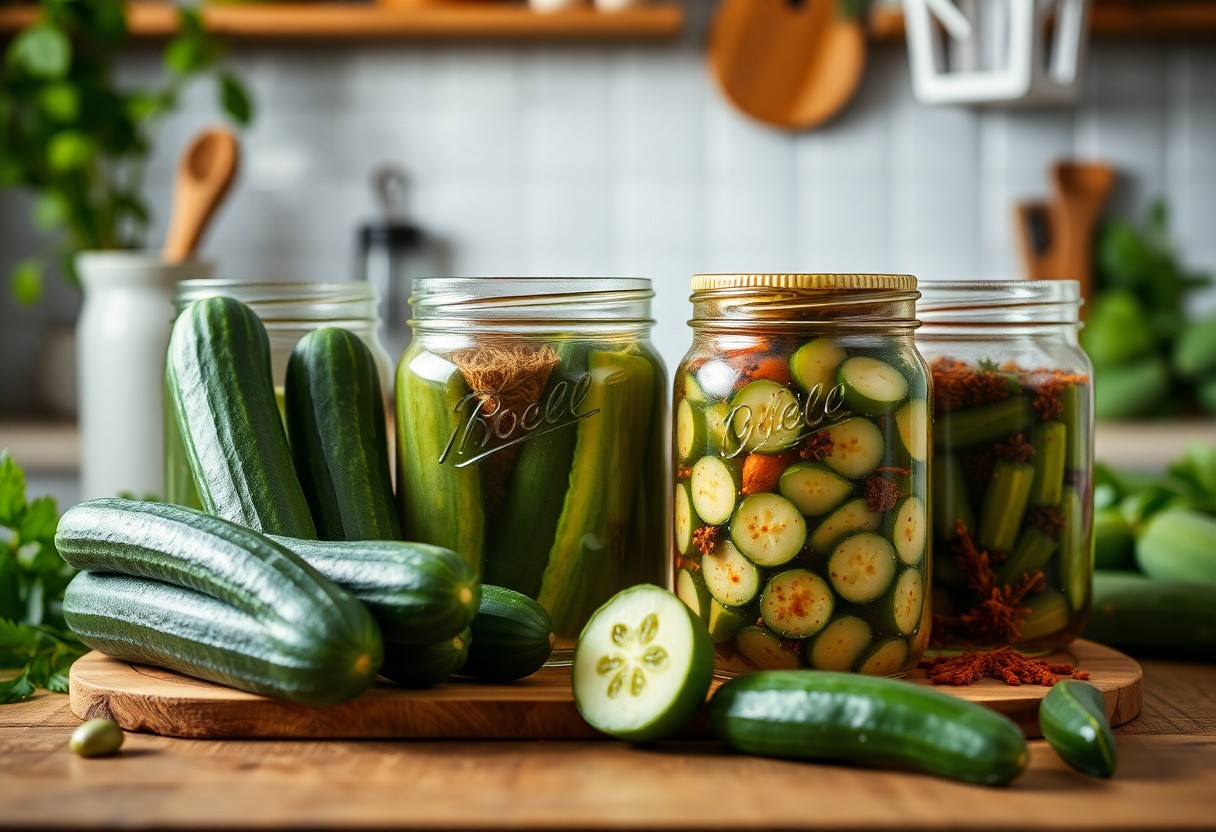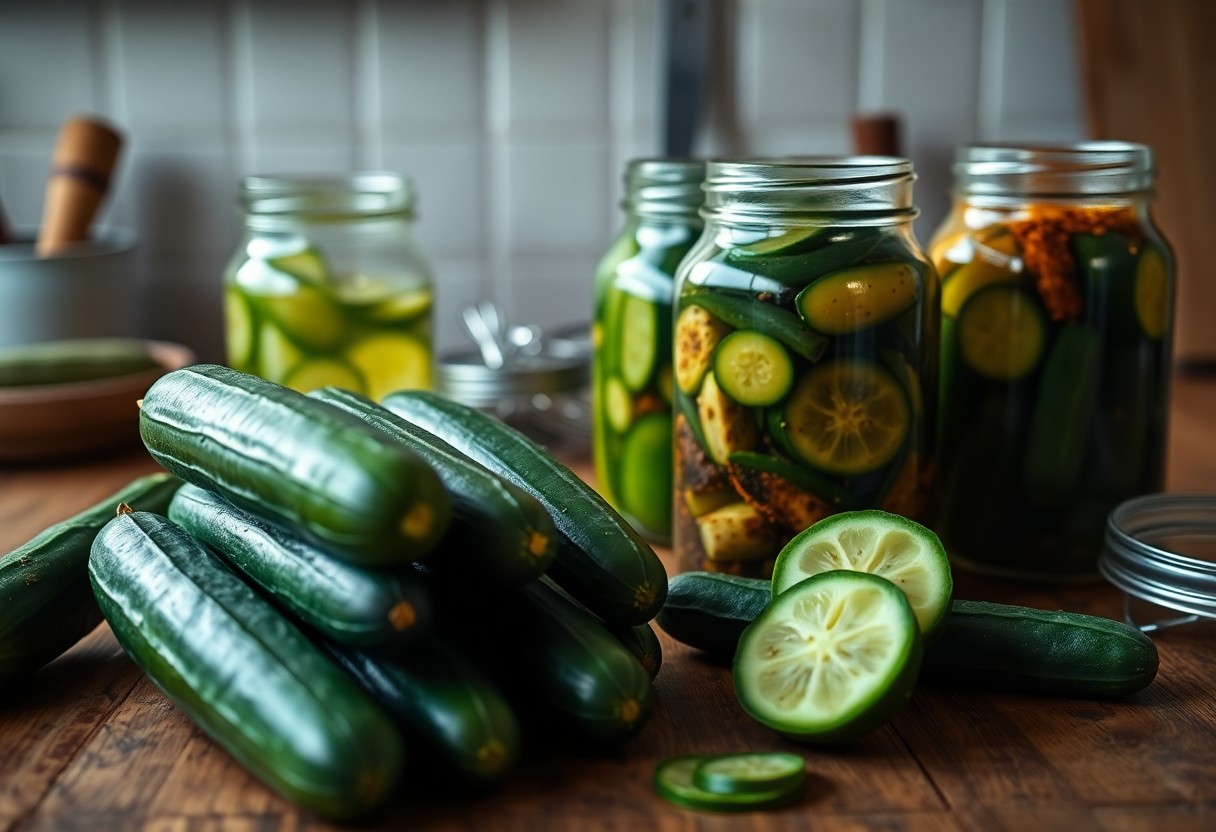How Do You Make Pickles Without Canning?
Just because you don’t have canning equipment doesn’t mean you can’t make delicious, crispy pickles at home. Quick pickling, also known as refrigerator pickling, offers you an easy way to preserve your vegetables without the hassle of traditional canning methods. Your homemade pickles can be ready to enjoy in as little as 24 hours, and they’ll keep well in your refrigerator for several weeks. With basic kitchen tools and simple ingredients you likely already have in your pantry, you can create fresh, flavorful pickles that rival store-bought versions.
Understanding the Basics of Pickling
While traditional canning methods require specific equipment and procedures, refrigerator pickling offers a simpler approach to preserve your vegetables. You’ll find this method particularly appealing as it allows you to create crisp, flavorful pickles without the need for specialized canning tools or extensive preparation time.
The Pickling Process Explained
There’s nothing complicated about refrigerator pickling. You simply need to combine vinegar, water, salt, and your chosen spices to create a brine, then pour it over your prepared vegetables. The acidic environment created by the vinegar solution prevents harmful bacteria growth while infusing your vegetables with delicious flavors.
Key Ingredients for Successful Pickling
Even with a simplified pickling process, you’ll need specific ingredients to achieve the best results. Your basic pickling toolkit should include white vinegar or apple cider vinegar, kosher salt (not iodized), fresh vegetables, and your preferred spices like dill, garlic, or peppercorns.
Pickling salt plays a vital role in your preservation process, helping to draw moisture out of vegetables while enhancing their flavor. You should avoid using table salt as it contains anti-caking agents that can make your brine cloudy. Your vinegar should have at least 5% acidity, and your vegetables must be fresh and firm for the best results.
How to Select the Right Cucumbers
The success of your refrigerator pickles largely depends on selecting the right cucumbers. Fresh, firm cucumbers with minimal blemishes and a uniform size will give you the best results. Choose cucumbers that are 4-6 inches long for optimal crunchiness and flavor absorption.
Recommended Varieties for Pickling
Right varieties make all the difference in your pickling journey. Kirby cucumbers are your best choice due to their firm texture and small size. You can also opt for Persian or Boston pickling cucumbers, which maintain their crispness well during the fermentation process.
Factors to Consider When Choosing Cucumbers
Even the freshest cucumbers need to meet specific criteria for successful pickling. Consider these imperative factors:
- Firmness and color consistency
- No soft spots or yellowing
- Uniform size for even pickling
- Unwaxed surface
This attention to quality ensures your pickles turn out crispy and flavorful.
With proper cucumber selection, you’ll need to examine additional characteristics:
- Harvest timing (morning is best)
- Skin thickness
- Seed content
- Growing conditions
This knowledge helps you create consistently excellent pickles every time.
Step-by-Step Guide to Making Quick Pickles
Assuming you want to make quick pickles, you’ll need to follow a systematic approach that involves preparing your vegetables, creating a pickling solution, and combining them properly. This straightforward process yields crisp, flavorful pickles in just a few days.
| Equipment | Clean jars, knife, pot, measuring cups |
| Time Needed | 30-45 minutes prep, 24-48 hours waiting |
Preparation of Ingredients
To begin your pickling journey, you’ll need to wash and cut your vegetables into uniform sizes. Your cucumbers, carrots, or other vegetables should be fresh and firm. Slice them into spears, chips, or any shape you prefer, keeping consistency in mind for even pickling.
The Pickling Solution
Preparation of your brine involves combining vinegar, water, salt, and sugar in specific ratios. You’ll want to heat these ingredients until the salt and sugar dissolve completely, then allow the mixture to cool slightly before use.
Pickles need a balanced brine to develop their characteristic tangy flavor. Your vinegar solution can be customized with various spices like dill, garlic, peppercorns, or mustard seeds to create your desired taste profile.
Combining Ingredients
There’s a simple art to combining your prepared vegetables and brine. You’ll want to pack your vegetables tightly in clean jars, add any additional seasonings, and pour the cooled brine over them until completely covered.
Ingredients should be fully submerged in the pickling solution to ensure proper preservation. After sealing your jars, you can store them in the refrigerator where they’ll develop their flavor over the next 24-48 hours.
Tips for Flavor Enhancement
Keep your pickling journey exciting by mastering the art of flavor enhancement. Your pickles can range from classic dill to exotic spice-infused varieties, depending on your seasoning choices. Adding fresh herbs, whole spices, and aromatic vegetables creates layers of complexity in your brine. Recognizing the balance between salt, vinegar, and seasonings will help you achieve perfect flavor profiles every time.
Using Spices and Herbs
An imperative aspect of pickle-making lies in your selection of spices and herbs. You can enhance your pickles with:
- Fresh dill, garlic, and peppercorns for traditional flavors
- Bay leaves and mustard seeds for depth
- Red pepper flakes for heat
- Celery seeds for subtle earthiness
- Fresh thyme or oregano for Mediterranean notes
Experimenting with Flavor Combinations
Clearly, your pickling adventure opens doors to endless flavor possibilities. You can mix and match different spices, herbs, and aromatics to create your signature pickle recipe. Consider pairing classic ingredients with unexpected additions like ginger, turmeric, or even citrus zest to develop unique taste profiles.
With careful attention to proportions, you can create bold new combinations. Start by adding small amounts of new ingredients to your basic recipe, then adjust based on taste preferences. Your experimentation might lead to discovering exciting flavor combinations like dill-curry, garlic-rosemary, or spicy Asian-inspired variations.
Storage and Safety Precautions
Your refrigerator pickles need proper storage to maintain their quality and safety. While these quick pickles don’t require traditional canning methods, following basic food safety guidelines will help you enjoy your pickles safely. Keep them refrigerated at all times and use clean utensils when handling to prevent contamination.
Ideal Storage Conditions
Conditions for storing your refrigerator pickles should include temperatures between 35-38°F (2-3°C). Keep them in airtight glass containers with non-reactive lids, and ensure the vegetables remain fully submerged in the brine. You can expect your pickles to stay fresh for 4-6 weeks when stored properly.
Signs of Spoilage
Storage safety requires you to monitor your pickles regularly for any signs of spoilage. Watch for changes in color, unusual cloudiness in the brine, mold growth, or off-putting smells. If you notice any of these signs, discard the entire batch immediately.
To ensure your pickles remain safe to eat, inspect them before each use. Look for fizzing or bubbling in the brine, which can indicate fermentation. Check for any sliminess on the vegetables or discoloration. You should also trust your senses – if the pickles smell yeasty or unpleasant, or if the taste seems off, it’s better to discard them.
Common Mistakes to Avoid
All pickle-making endeavors require attention to detail and patience. As you venture into refrigerator pickling, being aware of common pitfalls will help you achieve crisp, flavorful results. Here are the key mistakes you need to avoid for successful pickle-making at home.
Overlooking Ingredient Ratios
Overlooking the proper balance of vinegar, water, and salt can result in pickles that are either too sour, too bland, or prone to spoilage. You need to maintain the right proportions – typically a 1:1 ratio of vinegar to water, and 2-3 tablespoons of salt per quart of liquid – to ensure safe preservation and optimal taste.
Not Allowing Enough Time for Pickling
There’s a common tendency to rush the pickling process, but patience is necessary for the best results. Your vegetables need adequate time to absorb the brine and develop their characteristic tangy flavor. Most quick pickles require at least 24 hours in the refrigerator before they’re ready to eat.
With refrigerator pickles, timing plays a vital role in flavor development. Your pickles will continue to develop more complex flavors over the first few days. While you can taste them after 24 hours, waiting 48-72 hours will give you a more robust flavor profile. Keep in mind that different vegetables require different pickling times – thin-sliced cucumbers might be ready sooner, while thicker vegetables need more time.
Final Words
Ultimately, making pickles without canning offers you a quick and accessible way to enjoy homemade pickled vegetables. By following the refrigerator pickling method, you can create crisp, flavorful pickles that last for weeks in your fridge. Your success depends on maintaining proper ratios of vinegar, salt, and water while ensuring clean containers and fresh ingredients. Once you master these basic techniques, you’ll find yourself experimenting with different vegetables and spice combinations to create your own signature pickle recipes. This simple preservation method puts delicious, homemade pickles within your reach any time of year.








